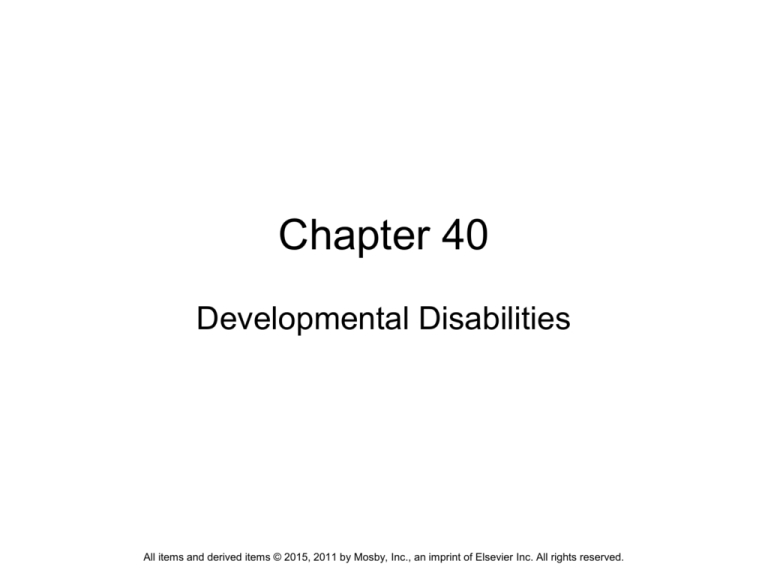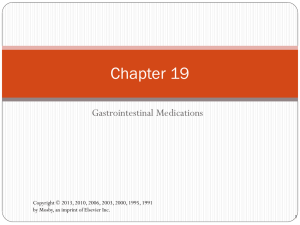
Chapter 40
Developmental Disabilities
All items and derived items © 2015, 2011 by Mosby, Inc., an imprint of Elsevier Inc. All rights reserved.
Disability
A disability is any lost, absent, or impaired physical
or mental function.
A birth defect is an abnormality present at birth that
can involve a body structure or function. Some
infants have birth defects that result in disabilities or
death .
Childhood illness and injuries can result in
disabilities.
A disability occurring before 22 years of age is called
a developmental disability (DD).
A DD can be a physical or mental impairment or both.
It is severe and permanent.
All items and derived items © 2015, 2011 by Mosby, Inc., an imprint of Elsevier Inc. All rights reserved.
2
Developmental Disability
With DDs, function is limited in three or more life
skills:
Self-care
Understanding and expressing language
Learning
Mobility
Self-direction
Capacity for independent living
Economic self-sufficiency (supporting oneself financially)
Developmentally disabled children become adults.
A DD affects the family throughout life.
All items and derived items © 2015, 2011 by Mosby, Inc., an imprint of Elsevier Inc. All rights reserved.
3
OBRA and ADA
Some nursing centers admit developmentally
disabled adults.
OBRA requires that centers provide ageappropriate activities for them.
Staff must have special training to meet their care
needs.
All items and derived items © 2015, 2011 by Mosby, Inc., an imprint of Elsevier Inc. All rights reserved.
4
Intellectual Disabilities (Mental
Retardation)
An intellectual disability involves severe limits in
intellectual function and adaptive behavior.
Intellectual function relates to learning, thinking, reasoning,
and solving problems.
Adaptive behaviors are ones needed to function in everyday
life.
The Arc of the United States describes intellectual
disability as:
An IQ score of about 70 or below
A significant limit in at least one adaptive behavior
The condition being present before 18 years of age
All items and derived items © 2015, 2011 by Mosby, Inc., an imprint of Elsevier Inc. All rights reserved.
5
The Arc
According to the Arc, alcohol is the leading
preventable cause of intellectual disabilities.
Brain development is impaired.
Intellectual disabilities range from mild to severe.
The Arc believes that:
Persons with intellectual disabilities must be able to enjoy
and maintain a good quality of life.
Children should live in a family and live and play with
children without disabilities.
As adults they should control their lives to the greatest extent
possible.
The Arc recognizes the sexuality of persons with
intellectual disabilities and related developmental
disabilities.
All items and derived items © 2015, 2011 by Mosby, Inc., an imprint of Elsevier Inc. All rights reserved.
6
Down Syndrome
DS is the most common genetic cause of mild
to moderate intellectual disability (mental
retardation).
It is caused by an error in cell division (an extra
21st chromosome is present).
It occurs at fertilization.
The child with DS has certain features caused
by the extra chromosome.
Many children with DS have other health
problems as well.
All items and derived items © 2015, 2011 by Mosby, Inc., an imprint of Elsevier Inc. All rights reserved.
7
Down Syndrome (Cont’d)
Dementia may appear in adults with DS.
Persons with DS:
Need speech, language, physical, and
occupational therapies
Need health and sex education
Need a healthy diet and regular exercise
All items and derived items © 2015, 2011 by Mosby, Inc., an imprint of Elsevier Inc. All rights reserved.
8
Fragile X Syndrome
FXS is the most common form of inherited
intellectual disabilities.
Signs and symptoms vary.
With FXS there is a change in the gene that
makes a protein needed for brain development.
Girls often have milder symptoms than boys.
Common disabilities include learning disabilities,
social and emotional, behavior problems, speech
and language problems, and sensitivity to sensory
input.
FXS has no cure.
All items and derived items © 2015, 2011 by Mosby, Inc., an imprint of Elsevier Inc. All rights reserved.
9
Cerebral Palsy
CP is a term applied to a group of disorders involving
muscle weakness or poor muscle control.
The defect is in the motor region of the brain.
Causes include:
Lack of oxygen to the brain (the usual cause)
Brain defects from faulty brain development
There is no cure.
These types are the most common:
Spastic cerebral palsy
Athetoid cerebral palsy
All items and derived items © 2015, 2011 by Mosby, Inc., an imprint of Elsevier Inc. All rights reserved.
10
Cerebral Palsy (Cont’d)
Certain terms describe the body parts
involved:
Hemiplegia
Diplegia
Quadriplegia
The person with CP can have other health
problems.
Care needs depend on the degree of brain
damage.
The goal is for the person to be as
independent as possible.
All items and derived items © 2015, 2011 by Mosby, Inc., an imprint of Elsevier Inc. All rights reserved.
11
Autism
Autism begins in early childhood.
It is a brain disorder with no cure.
The child has:
Problems with social skills
Verbal and nonverbal communication problems
Repetitive behaviors and routines and narrow
interests
Autism is more common in boys than girls.
The disorder can range from mild to severe.
All items and derived items © 2015, 2011 by Mosby, Inc., an imprint of Elsevier Inc. All rights reserved.
12
Autism (Cont’d)
The cause of autism is unknown.
Many therapies are used. With therapy, the
person can learn to change or control
behaviors.
The person needs to develop social and work
skills.
Persons with autism may have other
disorders.
All items and derived items © 2015, 2011 by Mosby, Inc., an imprint of Elsevier Inc. All rights reserved.
13
Spina Bifida
Spina bifida is a defect of the spinal column.
The defect occurs during the first month of
pregnancy.
Hydrocephalus often occurs with spina bifida.
In spina bifida, vertebrae do not form
properly.
Spina bifida can occur anywhere in the spine.
The lower back is the most common site.
All items and derived items © 2015, 2011 by Mosby, Inc., an imprint of Elsevier Inc. All rights reserved.
14
Types of Spina Bifida
Types of spina bifida include:
Spina bifida occulta
• Vertebrae are closed
• Spinal cord and nerves are normal
Spina bifida cystica
• Meningocele
• Myelomeningocele (meningomyelocele)
All items and derived items © 2015, 2011 by Mosby, Inc., an imprint of Elsevier Inc. All rights reserved.
15
Hydrocephalus
With hydrocephalus, cerebrospinal fluid
collects in and around the brain.
The head enlarges.
Pressure inside the head increases.
Intellectual disabilities (mental retardation) and
neurologic damage occur without treatment.
A shunt is placed in the brain to allow
cerebrospinal fluid to drain from the brain.
The shunt must remain open (patent).
The person can have many problems.
All items and derived items © 2015, 2011 by Mosby, Inc., an imprint of Elsevier Inc. All rights reserved.
16
Quality of Life
Persons with DD have the right to live, learn,
work, and enjoy life.
The Americans With Disabilities Act of 1990 (ADA)
and the Developmental Disabilities Assistance and
Bill of Rights Act of 2000 further protect their
rights.
Some persons with DD need nursing center care.
They are further protected by OBRA.
Independence to the extent possible is the
goal for these persons.
All items and derived items © 2015, 2011 by Mosby, Inc., an imprint of Elsevier Inc. All rights reserved.
17




